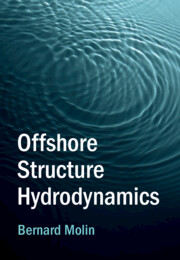Book contents
- Frontmatter
- Contents
- Preface
- Acknowledgments
- Symbols
- Abbreviations
- 1 Introduction
- 2 Environmental Conditions
- 3 Wave Theories
- 4 Wave and Current Loads on Slender Bodies
- 5 Flow-Induced Instabilities
- 6 Large Bodies: Linear Theory
- 7 Large Bodies: Second-Order Effects
- 8 Large Bodies: Other Nonlinear Effects
- 9 Model Testing
- Appendix A: Introduction to Potential Flow Theory
- Appendix B: Hydrostatics
- Appendix C: Damped Mass Spring System
- Appendix D: The Boundary Integral Equation Method
- Author Index
- Subject Index
- References
3 - Wave Theories
Published online by Cambridge University Press: 31 January 2023
- Frontmatter
- Contents
- Preface
- Acknowledgments
- Symbols
- Abbreviations
- 1 Introduction
- 2 Environmental Conditions
- 3 Wave Theories
- 4 Wave and Current Loads on Slender Bodies
- 5 Flow-Induced Instabilities
- 6 Large Bodies: Linear Theory
- 7 Large Bodies: Second-Order Effects
- 8 Large Bodies: Other Nonlinear Effects
- 9 Model Testing
- Appendix A: Introduction to Potential Flow Theory
- Appendix B: Hydrostatics
- Appendix C: Damped Mass Spring System
- Appendix D: The Boundary Integral Equation Method
- Author Index
- Subject Index
- References
Summary
Distinction is made between shallow water and deep water wave theories, depending on the value of the Ursell number. Potential flow theory is applied and the Stokes development is followed and first-order (linear), second-order, and third-order wave theories, in regular and irregular waves, are described. The concepts of phase and group velocities, mass transport, and energy flux are introduced. The application of stretching models to wave crest kinematics is described. At second-order distinction is made between bound (or locked) wave components (that accompany the first-order wave system) and free components (that travel independently). It is emphasized that, from third-order, such phenomena as mutual modifications of the phase velocities, or exchanges of energy, can take place between wave components. These interactions may lead to the occurrence of rogue waves, or to strong runups often observed at midships. The stream function wave model, which encompasses shallow and deep water cases, is presented. Finally the nonlinear Schr¨odinger equation that describes the time and space evolution of the wave envelope is applied to the prediction of the Benjaminis–Feir instability.
Keywords
- Type
- Chapter
- Information
- Offshore Structure Hydrodynamics , pp. 49 - 92Publisher: Cambridge University PressPrint publication year: 2023

